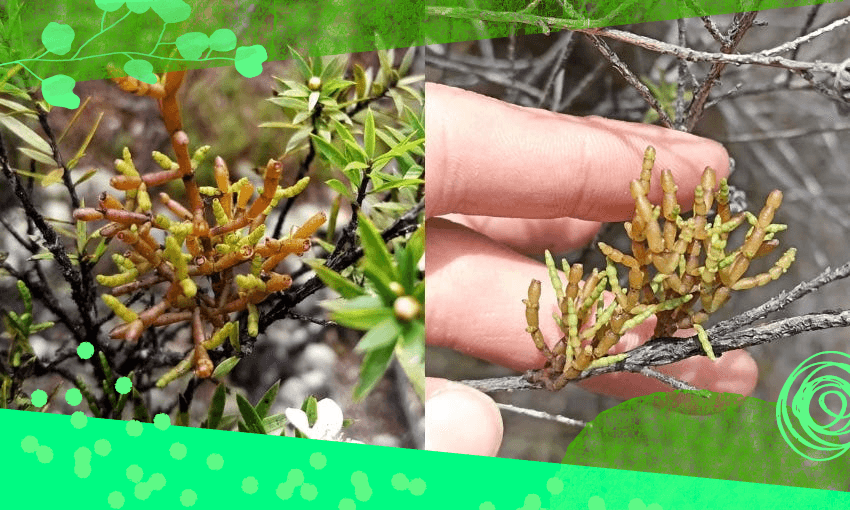Behind the pretty flower beds at Auckland Botanic Gardens, conservation mahi is under way for the region’s 357 threatened plants.
This is an excerpt from our weekly environmental newsletter Future Proof. Sign up here.
At Auckland Botanic Gardens, conservation specialist Ella Rawcliffe has been trying to plant a seed that’s smaller than a grain of sand. She can’t embed it in soil – this plant doesn’t have roots. Instead, she smooshes it into the cradle of a mānuka branch, marking its location with a spot of correction fluid.
The seed – collected from a West Auckland park – will hopefully grow into the “nationally critical” dwarf mistletoe (Korthalsella salicornioides). This oddball plant has “succulent-like” twiggy appendages instead of leaves, and like all mistletoes, is a parasite, requiring a host to survive. Classified as “nationally critical”, it now needs us to survive too.
The dwarf mistletoe is not alone: 357 of the 800 native plants found in Auckland are threatened species, according to Auckland Council’s Environmental Services team. They’ve spent the past 18 months figuring out “what plants are where, and how threatened they are,” says Emma Simpkins, senior regional advisor flora.
The plants in trouble “range from little grasses and herbs, through to trees,” says Simpkins. Some are threatened because their habitat is fragmented, or disappearing, or they’re now only found in a single location. Many face threats related to climate change, “which is gonna be pretty challenging for us to manage,” she says. That’s where botanic gardens come in: “Those plants can be looked after, while we figure out the best way to manage them in the wild.”
Two-hundred and twenty-four plant species are candidates for safekeeping at the botanic garden (through seedbanking or propagation, to safeguard their genetics) and work is under way to figure out top priorities. Rawcliffe and the team at the botanic garden, meanwhile, have a different challenge. “Most of these plants have never been grown before,” says Rawcliffe. “We’ve got to figure out how to propagate them.” Something like mistletoe is “very challenging,” she says.
Some threatened plants are already under the care of the Auckland Botanic Gardens, including the Auckland species of ngutukākā/kākābeak (Clianthus puniceus), which was found on Moturema Island in Kaipara Harbour but is now extinct in the wild.
This conservation and research side of botanic gardens – not just in Auckland, but across Aotearoa – often flies under the radar. Botanic gardens are more than just a pretty flower bed, says Rawcliffe, “There’s also a lot of education and training we take on – from horticultural apprentices to schoolkids – inspiring that connection with plants.”
This Sunday 26 May, Rawcliffe will be leading a walk-and-talk through the gardens, focused on its rare and threatened residents. It’s part of a wider Botanic Gardens Day annual celebration – organised by peak industry body Botanic Gardens Australia and New Zealand – with events happening across New Zealand and Australia that aim to reveal these hidden botanical treasures in our towns and cities.
It’s the perfect time of year to get (re)acquainted with your local gardens, says Rawcliffe. “There’s some good autumn colour – walking around the garden at the moment is very beautiful.”
And it’s always a perfect time to connect with plants – including those that need some TLC, like our friend the dwarf mistletoe.
“Just because we don’t necessarily know right now the value of that little herb, or that little grass, they might be playing an important part in the ecosystem,” says Simpkins. “Plants are everything. Plants are life.”

